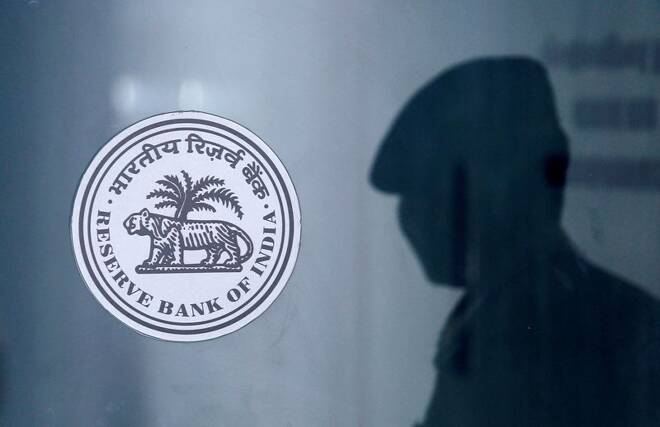Advertisement
Advertisement
India cenbank hikes rates 25 bps as expected, hints more could come
By:
MUMBAI (Reuters) - The Reserve Bank of India's key repo rate was raised by 25 basis points (bps) on Wednesday as widely expected, the sixth straight increase, as core inflation remained high despite signs retail inflation has peaked.
By Swati Bhat and Sudipto Ganguly
MUMBAI (Reuters) – The Reserve Bank of India hiked its key repo rate by a quarter percentage point on Wednesday as expected but surprised markets by leaving the door open to more tightening, saying core inflation remained high.
The central bank said that its policy stance remains focused on the withdrawal of accommodation, with four out of six members voting in favour of that position.
Most analysts had expected a hike on Wednesday to be the final increase in the RBI’s current tightening cycle, which has seen it raise rates by 250 bps since May last year.
A growing number of central banks around the world have signalled a pause or halt in their tightening campaigns in recent weeks as consumer inflation comes off the boil and growth in their economies shows signs of softening.
Indian stocks extended modest gains after the decision, while bond yields rose and the rupee was little changed.

The monetary policy committee (MPC), comprising three members from the central bank and three external members, raised the key lending rate or the repo rate to 6.50%, also in a split decision. Four of the six members voted in favour of the move.
“The stickiness of core or underlying inflation is a matter of concern. We need to see a decisive moderation in inflation. We have to remain unwavering in our commitment to bring down inflation,” RBI Governor Shaktikanta Das said as he announced the committee’s decision.
While the effects of earlier rate hikes are still working their way through the economy, further calibrated monetary policy action is warranted, Das added.

In a poll conducted ahead of the federal budget on Feb. 1, more than three-quarters of economists, 40 of 52, had expected the RBI to raise the repo rate by 25 bps. The remaining 12 predicted no change.
Das said that the inflation-adjusted, real interest rate remains below pre-pandemic levels and liquidity remains surplus, even though it is lower than during the pandemic.
The RBI has brought down the liquidity surplus in the banking system to below 2 trillion rupees ($24.19 billion) from around 9-10 trillion rupees in the aftermath of pandemic-related support measures.

India’s annual retail inflation rate eased to 5.72% in December from 5.88% in the previous month, falling below the RBI’s upper tolerance band of 2%-6% for a second straight month, though core inflation, which excludes more volatile food and fuel prices, was still running at 6.1%.
Consumer inflation is projected to be at 6.5% in the fiscal year 2023 and 5.3% for the fiscal year 2024.
“It seems reasonable to conclude that until (some) measures of inflation present less of a threat, by falling below 6% and remaining there for a couple of months, we can’t rule out further rate hikes,” economists at ING said in a note.
“So we will be amending our forecasts and adding a further 25 bps, taking peak policy rates to 6.75% after this latest increase and pushing back the timing of eventual rate cuts until next year.”
Capital Economics said it believes the hiking cycle has ended, but noted there was clearly a possibility of another increase in April, with plenty hinging on inflation readings for January and February.
Das added that the Indian economy looks resilient even though considerable uncertainties remain on global commodity prices. The RBI has projected a growth rate of 6.4% for fiscal year 2024.
“The global economic outlook does not look as grim now as it did a few months ago. Growth prospects in major economies have improved, while inflation is on a descent though still remains well-above target in major economies. The situation remains fluid and uncertain,” Das said.
Deputy RBI Governor Michael Patra said the GDP projections for the next financial year look achievable.
“Core inflation is sticky… But (it) will moderate if monetary policy remains resolute,” Patra said in a post meeting news conference.
The Indian rupee was little changed to the U.S. dollar at 82.69 compared with 82.67 prior to the policy announcement. It briefly rose to 82.62 after RBI maintained its withdrawal of accommodation stance.
The benchmark bond yield was at 7.3391% against 7.3124% before the policy decision and the previous close of 7.3102%.
The Nifty 50 index was up 0.78% at 17,860.50, as of 11:39 a.m. IST, while the S&P BSE Sensex rose 0.69% to 60,701.39.
($1 = 82.6830 Indian rupees)
(Reporting by Swati Bhat and Sudipto Ganguly; additonal reporting by Nupur Anand; Editing by Kim Coghill)
About the Author
Reuterscontributor
Reuters, the news and media division of Thomson Reuters, is the world’s largest international multimedia news provider reaching more than one billion people every day. Reuters provides trusted business, financial, national, and international news to professionals via Thomson Reuters desktops, the world's media organizations, and directly to consumers at Reuters.com and via Reuters TV. Learn more about Thomson Reuters products:
Latest news and analysis
Advertisement
